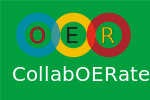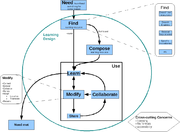Agile wOERkflow
| Work in progress, expect frequent changes. Help and feedback is welcome. See discussion page. |
Draft notes, thoughts, ideas and questions
- This is a strategic project inspired by David Porter's search for an agile workflow for creating, reusing and remixing OER.
- See Kim Tucker's visual flow of the OER Cycle
- Add your thoughts here ...
Not quite sure what the connection is. There is some visual resemblance with the SCRUM graph. But not clear adoption of the agile values.
According to the Manifesto, the values are:
Individuals and interactions over processes and tools
Working software over comprehensive documentation
Customer collaboration over contract negotiation
Responding to change over following a plan
That is, while there is value in the items on the right, we value the items on the left more.
A critical part that is missing is "customer collaboration". The primary customer of learning can be understood as the student. Secondary customers can be schools (success rate can affect reputation) and government (the material must meet some standards). Yet, the graph ends with "meets met" when nowhere in the process is there any attempt to collect feedback from the customers.
If you take the scrum process that the graph seems to be based on, Scrum is used to enable change while avoiding a perpetually moving target. Iterations are proposed, most of the time 2 or 4 weeks. Before an iteration, the set of features that are to be developed in the coming iteration are defined. During an iteration, the team is allowed to only work on the features that have been defined. The idea here is that you initially aim for a fully functional but minimalist product. Then, with new iterations, you add new features.
Not clear how this can apply to teaching material. Can you aim to teach a quarter of the curriculum the first year, then add on more "learning features" over the next years. Not clear.
It may be useful, however, to think in terms of chunk when you are preparing a transition. For instance, a transition between analogical media (printed textbooks) and digital ones (wikibooks, interactive content, etc.).
I have had a chance to read on agile and to practice it in a software development environment. I will try and spend more time writing on how transferable these ideas can be to education. Central to the agile approach is being open to change. Change is something that needs to be actively managed.
In the meantime, some books can be read (even if only some chapters) on google books.

